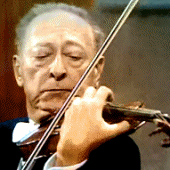| St. Petersburg |
![]()
The
city of St. Petersburg certainly did not disappoint. It's bewitching beauty engulfed us from the moment we arrived at the traditional city center, the Nevsky Prospect, the palaces - and of course the Hermitage - the galleries, the magnificent churches, the water canals, the sculptures and statues at every corner, the architecture. It is all on such grand scale, such beauty, little wonder the city is nicknamed 'the Paris of the East'.I can imagine little Jascha standing in awe of such grandeur - far beyond any scale he was accustomed to in his native Vilnius - the moment he arrived at the railway station in the city (see clips of the station on the Making the Documentary page). The Rimsky-Korsakov Conservatory and the Maryinsky Theatre were first on our itinerary, the Philharmonic Hall and of course Heifetz's various flats where he resided with his family during his six years studies in the city. Guided by the kind and knowledgeable author Mrs. Galina Kopytova and Albina Starkova-Heifetz (Robert Heifetz's widow), and aided by our wonderful Russian interpreter Elena Fomicheva, we roamed the streets, sailed on the river, interviewed a plethora of interesting people and visited Heifetz's homes.
The beautiful, proud Conservatory was a pleasure to visit, with its archives, storage museum (the Glazunov artifacts were particularly impressive) and the manuscript department. I often wondered why the Conservatory was named after Rimsky-Korsakov, since it was actually founded in 1862 by the pianist/composer Anton Rubinstein, who served twice as its director. Rimsky-Korsakov only joined the faculty in 1871 and had never been it's director. Interestingly, even though Rubinstein's tenure as director spanned two separate periods (1862-67 and 1886-1891), the Conservatory's longest serving director was none other than Alexander Glazunov (1905-28). Following the 1917 Revolution the title of 'director' was officially replaced with that of 'rector', a title carried on to the present day (currently: Prof. Sergei Stadler). Thus, Glazunov was the first to be bestowed the new title, enjoying the distinction of having been both a director and a rector. By all accounts - including Shostakovich's - Glazunov was a dedicated, hard working rector who did much for the Conservatory he loved. Jewish students were particularly grateful for his efforts to facilitate their residence in the city - not least of them Heifetz, Elman, Seidel, Milsten and others. When in 1917 he was asked by the Bolsheviks how many Jewish student he had at the Conservatory he replied "we don't keep count here". But by 1928, according to some, his bouts of alcoholism and disinterest with the Soviet Regime, caused him to retreat into a self-imposed exile, dying in Paris in 1936.
We went on the trail and the streets which Heifetz would have walked from his home to the Conservatory, or to the Great synagogue in which he celebrated his Bar-Mitzva in 1914, the Philharmonic Hall where he played on his return to Russia in 1934, and much more. A clip on the video taken from the balcony of the Philharmonic Hall shows the auditorium's proximity to the Grand Europa Hotel - it's actually across the street, opposite the Hall where, during his return to St. Petersburg Heifetz had lodged. Nevertheless, when he played in the Hall, a limo was sent to fetch him across the street, all of fifty yards of it...
The current occupants of the Heifetz former seventh (and last) apartment in St. Petersburg were somewhat less hospitable when we knocked on their door. It would appear that they are already alert to 'pilgrims' in recent times and wised up to the possibility that some money could be made from those 'foreigners' wishing to film the flat. Indeed, they demanded a high price for allowing us to enter. Negotiations went on for almost an hour, offers and refusals were made and received until we were finally allowed in for a brief visit. Alas, the apartment resembled nothing of its former glory. In its time the house was a handsome building with luxurious and expensive flats which by then the Heifetzes could obviously afford. It was a rather bourgeois apartment, on par with that of Leopold Auer's. In fact, the gradual refinement in the housing quality of the family all through their seven addresses in St. Petersburg can be seen to steadily improve as Heifetz's concert fees became progressively substantial. At his last address for example, there were altogether eleven family members and servants residing (some relatives from Vilnius lived with them). It was from this last address that the Heifetzes left for the USA and the one where they intended to return (the concert tour was initially contracted to last only four months). The Revolution though, had changed all that and the rest is history...
The famed St. Petersburg 'white nights' were in full bloom during our visit and the nights' aura added a further measure of magic to the scenery (during these nights the sun never fully sets).
I hope I had captured some of it.






